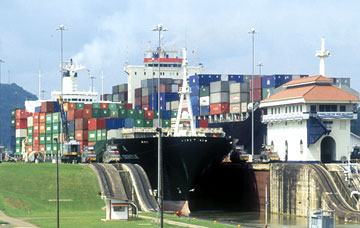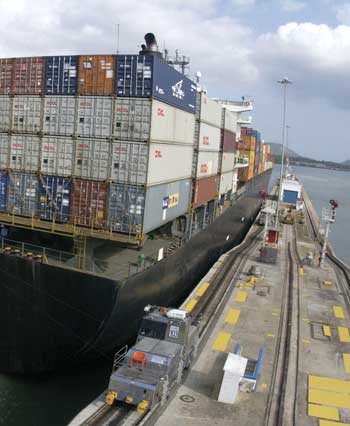| E |
ver- growing volumes of global trade are driving many of the world’s current great infrastructure projects. This is particularly true in some of the crossroads of commerce, such as the Panama Canal, and in the world’s burgeoning manufacturing centers, such as India.
Site Selection is focusing its global coverage of major infrastructure projects this year on projects taking shape in Central and South America as well as the Indian subcontinent.
Voters in Panama will have their say on Oct. 22 regarding one of the world’s greatest pending infrastructure projects, the long- awaited expansion of the 92- year- old
 |
| If the referendum passes, dredging could start as early as February 2007. The proposed new locks would be 74 feet (22.5 m.) wider and 435 feet (132.5 m.) longer than the current locks. |
Panama Canal, a $5.25- billion dollar plan that officials say will upgrade the passageway to handle larger, modern cargo vessels.
The project would double the canal’s capacity and would be paid for entirely by users of the canal through a graduated toll system. The plan involves creation of a new lane of traffic along the canal through the construction of a new set of locks. The proposed locks will be 74 feet (22.5 m.) wider and 435 feet (132.5 m.) longer than the Canal’s current locks.
Water- saving basins built alongside the new locks will reuse 60 percent of the water in each transit. The Panama Canal Authority, which took over operations of the canal following the U.S. handover on Dec. 31, 1999, says expansion will not interrupt current operations. Nearly 5 percent of world trade transits the Canal.
Maersk Inc., one of the largest shippers traversing the canal, believes its expansion is crucial for fluid trade.
“Maersk supports the expansion of the Panama Canal,” says Jessica Kubacz, Maersk spokeswoman. “It would mean a positive development for world trade. There are currently 391 post- Panamax vessels greater than 5,200 TEU that cannot call on the U.S. East Coast. These vessels can only travel by way of the Suez Canal for the Hong Kong/South China market. The post- Panamax fleet will grow by 74 percent by 2010. Without expansion, the Panama Canal will decline in relative importance for the U.S. East Coast market. This is because larger ships can be deployed via the Suez Canal and serve that market from the ever- growing Hong Kong/South China region with comparable transit times.”
Of the canal’s trade, 88 percent flows between the U.S. and Asia. The project also has the endorsement of China Ocean Shipping Company (COSCO).
“The expansion will not only strengthen Panama financially by bringing considerable revenues, promoting development of Panama’s maritime industry and ensuring Panama’s position as the regional maritime center, but it will also benefit the growth of regional and world trade,” said Capt. Wei Jiafu, COSCO’s president and CEO.
Canal officials believe users are in agreement on the expansion project.
“The general reaction is they are pleased we are finally moving ahead with the project,” says Francisco Miguez, coordinator of the Panama Canal Authority expansion office. “They have reviewed the plans and believe everything will work fine for the whole industry. They understand the canal is approaching capacity and have come forward telling us they are behind it and understand we need to raise tolls to pay for the project. Nobody has voiced
 |
| The 92- year- old Panama Canal will be expanded to accommodate modern cargo ships if the country’s voters approve a $5.25- billion project in October. |
any complaints about it.”
But will Panamanian voters support the referendum? Miguez believes so.
“We’ve been doing a strenuous job of explaining the project to the people, and it seems most of the relevant questions have already been resolved,” Miguez says. “The public debate is not about the project itself or its benefits. It is about what are we going to do with the revenue that will accrue from the expanded canal. The project is going to be good for the country, good for the canal and good for the users. There are no guarantees, but we feel confident about the election.”
Miguez says if voters give a nod to the project, construction can begin in early 2007 with initial dredging by Panama Canal Authority personnel. The new locks will be built about a year and a half after the referendum.
“By February, we can start digging and we will see some progress,” Miguez says.
If all goes well, construction could be completed as early as 2013 with a late contingency target date of 2014, Miguez says. External financing of the project won’t be needed until the third year of construction.
“That gives us time to start construction and excavation while raising funds,” Miguez says. “We are very confident we can get financing in very good terms from many sources. Construction of the canal was accomplished in 1914 with picks and steam shovel technology. Now, with 21st century technology, the project is a very moderate risk. During the last 20 years, the canal has been dredged [of] the same amount of material that we are proposing to dredge in this project. None of the technology needed for construction is experimental.”
Miguez says the Canal Authority anticipates significant growth in industries related to canal traffic. Development of industrial parks along the expanded canal will be conducted by government agencies or by private investors.
“We believe there will be increased development by logistics companies of services to vessels transiting the canal,” Miguez says. “The cluster of service industries that have been growing around the canal will triple over the next 20 years as we add the ability to handle post- Panamax service.”
Miguez cites ambitious job- creation projections related to the project and its construction. These include 7,000 direct construction jobs, 35,000 support jobs and 150,000 to 250,000 jobs by 2025 in the Canal area’s logistics cluster.